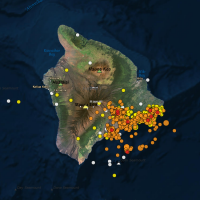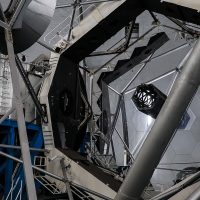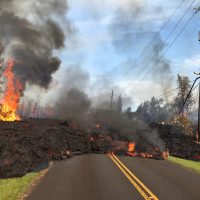The ground beneath us is one constant in life you just expect to never change. Solid and unyielding, we build our lives upon the firm foundations of the Earth. When this constant betrays us it is truly disconcerting. The world loses some of its comforting stability.
Last Friday was a day when our islands were reminded of the instability of our world in a rather abrupt fashion.

The tiltmeters indicated that pressure in the caldera and Puʻu Oʻo had been building steadily. At the same time the activity in the 61g lava had been waning. Where was the magma going?
While speculation was rife, no one really knew what was coming. Three decades of eruptions from Puʻu Oʻo has become somewhat routine. People forget that Kilauea can be, and usually is much more unpredictable. That destruction can appear anywhere on her flanks.

We worried about the homes in the neighborhood and the people we knew who lived in the area. We compared notes, recalling who lived exactly where, fearing the lava flows would quickly spread. This was looking like a worst case scenario, a repeat of 1955 with more people and homes in the way.
Despite the outbreaks of lava in the rift zone the previous afternoon, we expected a routine Friday atop Mauna Kea. I had a list of tasks to complete… Inspect the K1 azimuth wrap, drill some anchor points to allow installation of the new ice monitor receiver on the roof, look for some spare parts for an encoder.
It should be an easy day on the summit… It was not.
Friday became a day I will remember for a long time to come.
The first notable quake occurred at 11:32am, a magnitude 5.4 under the southern flank of Kilauea near Kalapana. The quake was strong enough to be easily felt atop the mauna, where we experienced a strong rolling motion that rattled the building.
The scheduled activity of the day was put aside, the parts and tools I had been gathering for the next task still lie forgotten in the electronics shop. We gathered in the hall to account for everyone, then began a quick survey of the facility for any damage requiring immediate attention.
We have a defined procedure to be performed whenever a strong earthquake occurs. A systematic check of the facility to be done before regular operation resumes. Teams were quickly formed for each telescope, I found myself leading the team on Keck 1.
By late morning I think every computer in the observatory was displaying the USGS earthquake map. The live map was littered with hundreds of angry red and orange circles across the south and eastern flanks of Kilauea. Many of the quakes were disconcertingly large, a lot of 3rd, 4th, and 5th magnitude events among the swarm of lesser quakes.
It was then that the strongest quake of the day reached us. Later we would find out it was a 6.9 magnitude quake, the strongest to rock the islands in four decades. The 2006 Puako quake that did so much damage to the island was slightly weaker at 6.7 magnitude.

Later I recalled that I was never really scared, rather I found myself fascinated by the motion. I was relatively secure underneath the Nasmyth platform, a sturdy structure of steel framework, it was probably a good place to be if things got truly violent.
From this place I had a clear view of the telescope as it danced back and forth in the pier. 370 tons of steel and glass attempting to stay still as the ground shook back and forth underneath it. It is a sight I will not soon forget.
The quake lasted longer than any I had yet experienced. The rolling just going on and on, it felt much longer than the 50 or so seconds the quake actually lasted.
We started the quake recovery checklist over again, again walking though the facility for any major damage than needed immediate attention.
The damage to the observatory was quite minor. One PRM sensor damaged, one of the encoder mounts damaged on Keck 1, the thin aluminum flexures destroyed, we have spare parts for that. The most serious damage are two of the azimuth radial bearings on Keck 1, slightly bent so that they are not in proper contact with the track. A third bearing looked marginal, needing some adjustment. This last bit took a few days to repair, the telescope back on sky Tuesday night.
When we realized that Keck 1 was going to be off sky for a day or two, we moved to the other end of the building. Keck 2 was in pretty good shape, our checkout revealing no issues with the telescope. It could have gone on-sky that night. The observatory opted to shut down for the night anyway, awaiting an even more thorough inspection for any possible damage and worried about yet another quake in the night.
This magnitude 6.9 is now my personal record for an experienced earthquake. I really do not need to go through another one.

While the first fissures in the neighborhood have quieted, new fissures continue to open further down the rift leaving the whole district wondering where the next will erupt bringing fire and destruction.


Me and Paul thoroughly enjoyed that report. It sums up the week rather well.
We will keep safe in puna and keep our masks handy. Thanks for the prayers
For the safety and feeling prayer your bloggers and fans are sending over here.
I think Pele is listening as no one has been seriously hurt or killed so far.
Aloha
I Hope everybody in Hawaii is staying safe. I had actually considered that area for moving to one day. Never got the job I could do remotely to allow it but still trying.
I was at home at the time of the big earthquake, about 20 miles from the epicenter, and on the top floor of my wooden house which is on posts. It’s not something I want to experience again. I had to hang onto by bed to stop falling over and just hearing the noise from downstairs as stuff fell out of the kitchen cabinets and everywhere else was disturbing. Not knowing how long it was going to go on or if it would get even stronger was scary. Since then, the aftershocks had me gripping anything nearby although fortunately the seismic activity is much reduced now. Unfortunately, the fissures and lava flows in lower Puna mean that thousands of people will likely have to evacuate. Around 2000 have already evacuated.
No damage at UKIRT and from all the reports I have received, I believe all the other observatories got through this relatively unscathed.
Tom